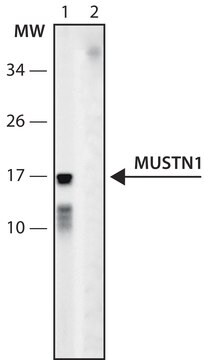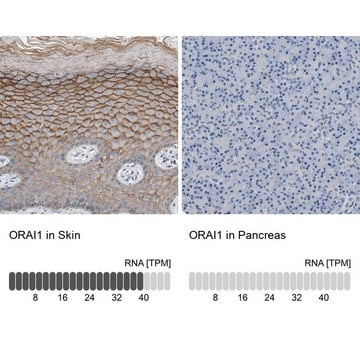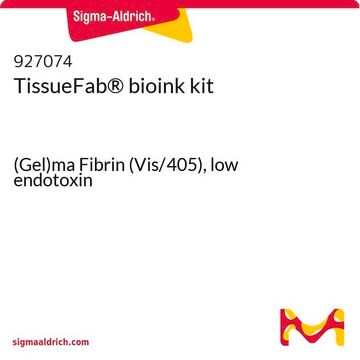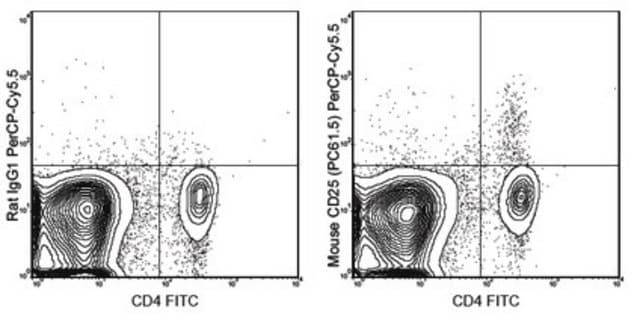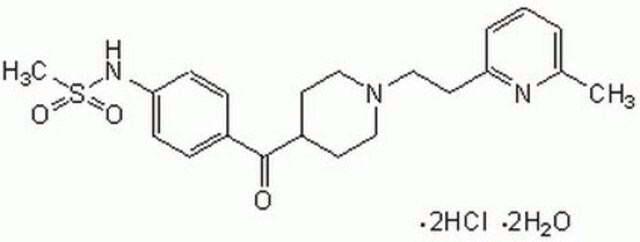推荐产品
生物来源
rabbit
质量水平
抗体形式
affinity isolated antibody
抗体产品类型
primary antibodies
克隆
polyclonal
纯化方式
affinity chromatography
种属反应性
human, mouse
种属反应性(根据同源性预测)
rat (based on 100% sequence homology)
包装
antibody small pack of 25 μg
技术
immunohistochemistry: suitable (paraffin)
western blot: suitable
同位素/亚型
IgG
NCBI登记号
UniProt登记号
运输
ambient
靶向翻译后修饰
unmodified
基因信息
human ... MUSTN1(389125)
一般描述
Musculoskeletal embryonic nuclear protein 1 (UniProt: Q8IVN3; also known a MUSTN1) is encoded by the MUSTN1 gene (Gene ID: 389125) in human. MUSTN1 is a small protein of the MUSTANG family that is found predominantly in the musculoskeletal system. It plays a role in the development and regeneration of the musculoskeletal system. It localizes to the nucleus and specifically, spatially in mesenchymal cells of the developing limbs and in the fracture callus in periosteal osteoprogenitor cells, proliferating chondrocytes, and young active osteoblasts. MUSTN1 sequence is highly homologous in vertebrates and contains a nuclear localization sequence without any other significant motifs. MUSTN1 is highly expressed during embryogenesis and is essential for chondrocyte proliferation and differentiation. (Ref.: Gersch, RP and Hadjiargyrou, M (2009). Bone 45(2); 330-338).
特异性
This rabbit polyclonal antibody detects Musculoskeletal embryonic nuclear protein 1 (MUSTN1) in human and mouse. It targets an epitope within 12 amino acids from the C-terminal region.
免疫原
Epitope: C-terminus
KLH-conjugated linear peptide corresponding to 12 amino acids from the C-terminal region of human Musculoskeletal embryonic nuclear protein 1.
应用
Anti-MUSTN1, Cat. No. ABD115, is a rabbit polyclonal antibody that detects human and murine Musculoskeletal embryonic nuclear protein 1 and has been tested for use in Immunohistochemistry (Paraffin) and Western Blotting.
Research Category
Cell Structure
Cell Structure
Western Blotting Analysis: 2 µg/mL from a representative lot detected MUSTN1 in human heart tissue lysate.
Immunohistochemistry Analysis: A 1:250-1,000 dilution from a representative lot detected MUSTN1 in human skeletal muscle, mouse embryo, and mouse embryonic lung tissues.
Immunohistochemistry Analysis: A 1:250-1,000 dilution from a representative lot detected MUSTN1 in human skeletal muscle, mouse embryo, and mouse embryonic lung tissues.
Western Blotting Analysis: 2 µg/mL from a representative lot detected MUSTN1 in human heart tissue lysate.
Immunohistochemistry Analysis: A 1:250-1,000 dilution from a representative lot detected MUSTN1 in human skeletal muscle, mouse embryo, and mouse embryonic lung tissues.
Immunohistochemistry Analysis: A 1:250-1,000 dilution from a representative lot detected MUSTN1 in human skeletal muscle, mouse embryo, and mouse embryonic lung tissues.
质量
Evaluated by Western Blotting in C2C12 cell lysate.
Western Blotting Analysis: 2 µg/mL of this antibody detected MUSTN1 in C2C12 cell lysate.
Western Blotting Analysis: 2 µg/mL of this antibody detected MUSTN1 in C2C12 cell lysate.
目标描述
~13 kDa observed; 8.91 kDa calculated. Uncharacterized bands may be observed in some lysate(s).
外形
Affinity Purified
Purified rabbit polyclonal antibody in buffer containing 0.1 M Tris-Glycine, 0.15 M NaCl, pH7.4 with 0.05% sodium azide.
Purified rabbit polyclonal antibody in buffer containing 0.1 M Tris-Glycine, 0.15 M NaCl, pH7.4 with 0.05% sodium azide.
储存及稳定性
Stable for 1 year at 2-8°C from date of receipt.
Stable for 1 year at 2-8°C from date of receipt.
其他说明
Concentration: Please refer to lot specific datasheet.
免责声明
Unless otherwise stated in our catalog or other company documentation accompanying the product(s), our products are intended for research use only and are not to be used for any other purpose, which includes but is not limited to, unauthorized commercial uses, in vitro diagnostic uses, ex vivo or in vivo therapeutic uses or any type of consumption or application to humans or animals.
未找到合适的产品?
试试我们的产品选型工具.
WGK
WGK 1
Serge Ducommun et al.
Molecular metabolism, 82, 101912-101912 (2024-03-09)
Skeletal muscle plasticity and remodeling are critical for adapting tissue function to use, disuse, and regeneration. The aim of this study was to identify genes and molecular pathways that regulate the transition from atrophy to compensatory hypertrophy or recovery from
Sara Di Persio et al.
Cell reports. Medicine, 2(9), 100395-100395 (2021-10-09)
Despite the high incidence of male infertility, only 30% of infertile men receive a causative diagnosis. To explore the regulatory mechanisms governing human germ cell function in normal and impaired spermatogenesis (crypto), we performed single-cell RNA sequencing (>30,000 cells). We
我们的科学家团队拥有各种研究领域经验,包括生命科学、材料科学、化学合成、色谱、分析及许多其他领域.
联系技术服务部门